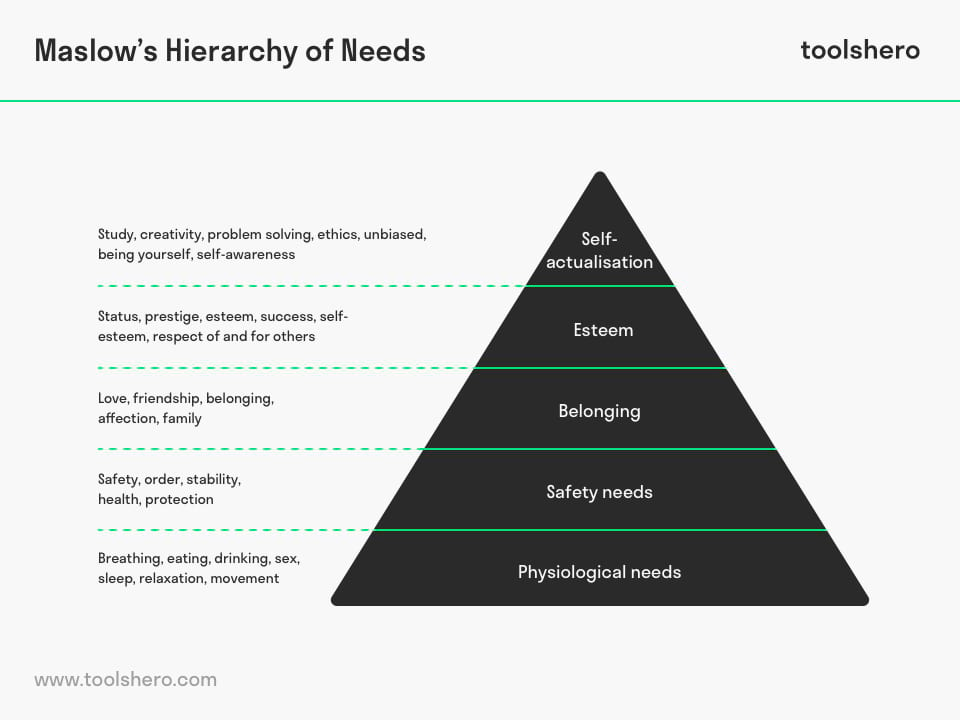Maslow’s Hierarchy of Needs Theory explained

Maslow’s Hierarchy of Needs: this article explains the theory of Maslow’s Hierarchy of Needs in a practical way. After reading about the theory and the levels of Maslow’s pyramid, you will understand the basics of this human motivation theory. Enjoy reading!
What is Maslow’s Hierarchy of Needs? The theory
What motivates people, what is their motive to do their work well, what are their human needs and basic needs, and how can they be encouraged to perform even better?
To get a better understanding of this process and these basic needs for personal growth, social needs and well being, the psychologist Abraham Maslow developed a pyramid model in 1934 based on empirical evidence, in which he described five different levels of gratification of needs. Maslow’s theory was focused on the development of individuals. Abraham Maslow believed that human beings are more likely to be happy and successful if their human basic needs were met.
This theory is known as Maslow Pyramid or Maslow theory of human behavior and is still used in the corporate sector, specifically in management training.
Maslow’s hierarchy of needs is about deficiency needs and growth needs
The five levels of this pyramid model are divided into deficiency needs and growth needs for self actualization of human beings. The first four levels are deficiency needs, also known as D needs. The top level of the pyramid is a growth need, or B need.
Deficiency needs ensure that human beings are motivated when the needs cannot be met. The motivation to meet these needs grows stronger as time goes by. A simple example: the longer a person has no water, the more thirsty that person will become.
The developer of this pyramid model, Abraham Maslow, argues that people must first meet deficiency needs before they can move on to meet their growth needs. He further states that this is not an all-or-nothing matter. Someone does not have to have need 1 completely satisfied before moving on to need 2.
When a need is more or less satisfied, the desire for this need will disappear and man will slowly focus on the next set of self actualization needs. These then become the most important self actualization needs in place of the previous ones.
The last category of Abraham Maslow’s hierarchy, the growth needs, will always be present, regardless of whether previous self actualization needs have been met.
Maslow’s Hierarchy of Needs: the Pyramid
According to Abraham Maslow, people are always motivated to satisfy their self actualization needs both at home and at work. He does not make distinctions based on age.
He categorized human needs into five hierarchical levels (Hierarchy of Needs). He made the assumption that an advanced level can only be reached when the previous level of self actualization needs has been fulfilled. When people do not have their needs satisfied, mental illness can occur.

Figure 1 – Maslow ‘s Hierarchy of Needs levels in a pyramid.
According to Abraham Maslow it is not possible to skip a level of the Hierarchy of Needs. That is why it is important to fulfil the need that has been skipped or lost at a later date.
The lower level is the foundation of the pyramid. This is where the self actualization needs pattern begins. These basic needs apply to everyone. The higher the level, the more difficult it becomes to satisfy the needs.
1. Physiological Needs
These physiological needs include the most basic needs that are vital to survival, such as the need for food, water and sleep (primary needs or basic human needs). Without fulfilment of these physiological needs, people cannot function properly and they can fall ill. Transition to work: A salary pays for most of these physiological needs (food and drink).
2. Safety Needs
Every person wants emotional security, financial security, safety, and stability (Secondary Needs). This can also be translated into peace, order and health.
This needs category also includes the security of a roof over one’s head. If you make the transition to work: steady work, for instance a long-term contract, provides stability and security for the long term. This ensures security with respect to housing and providing for the family.
3. Belonging
People are social beings and need social contacts. They wish to belong to a group. Friendship, acceptance, love and belonging and caring for other people and intimacy are important needs. Transition to work: an employee will only invest time in social contacts on the work floor and be loyal to colleagues when they have been given the security of a long-term contract. The employee now feels that they are more a part of the group.
4. Esteem
After investing in social contacts, people need self esteem and recognition for what they do (Recognition Needs). Examples of esteem needs are strength, self-belief, respect from others and self respect is crucial in this. Only then will they need self esteem, recognition and respect from other people.
Transition to the work place: The employer holds a motivator with this needs category. Apart from the height of the salary, there are other factors that can motivate an employee. As a result, compliments, trust and autonomy become important motivators for an employee. This is a great example of self esteem and it’s value.
5. Self-actualisation
Through the full development of certain qualities, this needs category will grow (Development Needs). This can take place in different manners; from taking a course or night classes to taking on hobbies. Transition to the workplace: Here too, motivators can be found.
Some employees are extra stimulated if they are allowed to do certain courses or studies. The incentive and appreciation for doing voluntary work, by offering a subsidy or leisure time, are part of this category. Even when all the needs in the pyramid have been met, people will not be satisfied.
According to Abraham Maslow people will always have the urge to develop themselves and to chase after new needs, to be better at what they are good at.
A top sportsman wants to perform even better, an artist wants to pour more soul into his work and a manager wants to have an even bigger company. This need is also called self-actualization.
Elaboration of the Self-Development Need of Maslow’s Pyramid
Maslow argues that people who have attained the need for self-actualization have seen all the previous like physiological needs, safety needs, etc. fulfilled. Self-actualization is also called self-realization or self-actualization.
This term refers to a need for personal growth that persists throughout life. According to Maslow, a person is therefore always evolving, never static. Since everyone is unique, self-fulfillment leads people in different directions. For some people this is art, or literature. For others, this is sport, a career or something else.
According to Abraham Maslow, self-actualization can be measured by peak experiences. These are the feelings of euphoria, joy and wonder that people experience when they experience the world to the maximum.
While everyone is basically capable of self-actualization, most people will only achieve their full potential to a limited extent. Only two percent of people, Maslow estimated.
Abraham Maslow identified fifteen characteristics of people who had reached this potential. Among these people were Abraham Lincoln and Albert Einstein. The features are:
- Tolerate uncertainty and perceive reality efficiently
- Accept themselves and others
- Are spontaneous in thinking and acting
- Are problem-oriented
- Have an unusual sense of humor
- Look at life objectively
- Are creative
- Thinking outside the box
- Are concerned about the well-being of people
- Are able to experience life intensely
- Create deep relationships with just a few people
- Have many peak experiences
- Need privacy
- Are pro-democratic
Have strong moral and ethical standards
Critical Comments on the Maslow’s Hierarchy of Needs Theory
Today, this theory is heavily criticized by scientists. There are situations in which it is not possible to substantiate the idea that these needs take place in a hierarchical order.
There are people who, despite very difficult circumstances, are perfectly capable of satisfying their social needs and who are capable of striving for recognition. Furthermore, the various needs can merge with one another and they can vary from situation to situation.
In a workplace it is especially the younger employees who have a need for social contact, where as their older colleagues want to be recognized for their achievements. As a third critical comment it could be said that Maslow’s Hierarchy of Needs is rather static. The needs of employees change and depend on time, the situation, experience and by comparing themselves with others.
Finally, Clayton Alderfer states in his ERG Theory of Motivation that people can regress to lower level needs despite the fact that these needs have already been fulfilled.
Now It’s Your Turn
What do you think? Is the theory of human motivation still applicable in today’s modern world? Do you recognize the practical explanation or do you have more suggestions? What are your success factors for motivation?
Share your experience and knowledge in the comments box below.
More information
- Gibson, F.K. & Teasley, C.E. (1973). The Humanistic Model of Organizational Motivation: A Review of Research Support. Public Administration Review 33, no. 1 (February 1973): 89-96.
- Maslow, A. H. (2013). A theory of human motivation. Start Publishing LLC.
- Maslow, A. H., Frager, R., & Fadiman, J. (1970). Motivation and personality (Vol. 2). Harper and Row.
- Wahba, M. & Bridwell, L. (1976). Maslow reconsidered: A review of research on the need hierarchy theory. Organizational Behaviour and Human Performance 15, no. 2: 212-240.
How to cite this article:
Mulder, P. (2012). Maslow’s Hierarchy of Needs. Retrieved [insert date] from Toolshero: https://www.toolshero.com/psychology/hierarchy-of-needs-maslow/
Published on: 13/01/2012 | Last update: 02/28/2024
Add a link to this page on your website:
<a href=”https://www.toolshero.com/psychology/hierarchy-of-needs-maslow/”>Toolshero: Maslow’s Hierarchy of Needs</a>












